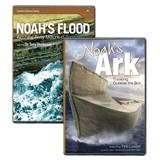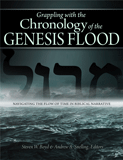
Biblical Overview of the Flood Timeline
Bodie Hodge, AiG-U.S., offers an overview of the timing of the events of the Flood according to Scripture.
An examination of the Flood account in Genesis 6–8 gives some time-related milestones that form the overall structure in the progression of the year-long global Flood. Table 1 briefly summarizes these milestones that can help us understand some of the geologic details of the Flood.
| Timeline (days) | Duration | Month/Day | Description | Bible Reference |
|---|---|---|---|---|
| 0 | Initial reference point | 600th year of Noah’s life: 2nd month, 17th day of the month | The fountains of the great deep broke apart and the windows of heaven were opened; it began to rain. This happened on the seventeenth day of the second month. Noah actually entered the Ark seven days prior to this. | Genesis 7:11 |
| 40 | 40 days and nights | 3rd month, 27th day of the month | Rain fell for 40 days, and then water covered the earth’s highest places (at that time) by over ~20 feet (15 cubits) and began the stage of flooding until the next milestone.2 | Genesis 7:11–12, Genesis 7:17–20 |
| 150 | 150 days (including the initial 40 days) | 7th month, 17th day of the month | The water rose to its highest level (covering the whole earth) sometime between the 40th and 150th day, and the end of these 150 days was the seventeenth day of the seventh month. The Ark rested on the mountains of Ararat. On the 150th day, the springs of the great deep were shut off, and the rain from above ceased, and the water began continually receding. | Genesis 7:24–8:5 |
| 150 + 74 = 224 | 74 days | 10th month, 1st day of the month | The tops of the mountains became visible on the tenth month, first day. | Genesis 8:5 |
| 224 + 40 = 264 | 40 days | 11th month, 11th day of the month | After 40 more days, Noah sent out a raven. | Genesis 8:6 |
| 264 + 7 = 271 | 7 days | 11th month, 18th day of the month | The dove was sent out seven days after the raven. It had no resting place and returned to Noah.3 | Genesis 8:6–12 |
| 271 + 7 = 278 | 7 days | 11th month, 25th day of the month | After seven more days, Noah sent out the dove again. It returned again but this time with an olive leaf in its beak. | Genesis 8:10–11 |
| 278 + 7 = 285 | 7 days | 12th month, 2nd day of the month | After seven more days, Noah sent out the dove again, and it did not return. | Genesis 8:12 |
| 314 | 29 days | 601st year of Noah life: 1st month, 1st day of the month | Noah removed the cover of the Ark on the first day of the first month. The surface of the earth was dried up, and Noah could verify this to the extent of what he could see. | Genesis 8:13 |
| 370 (371 if counting the first day and last day as full days) | 56 days | 2nd month, 27th day of the month | The earth was dry, and God commanded Noah’s family and the animals to come out of the Ark. From the first day of the year during the daylight portion there were 29.5 more days left in the month plus 26.5 more days left in the second month until the exit. | Genesis 8:14–17, Genesis 7:11 |
Because the biblical account is a reliable record of earth history, it is to be expected that these milestones would be significant in correlating the prominent geological features preserved in the rock record. For example, we are told that the onset of the Flood was triggered by the breaking up of the fountains of “the great deep.” This would imply a violent beginning to the Flood, as springs or fountains of water burst forth to spew vast quantities of water and perhaps other material onto the surface from deeper inside the earth. Furthermore, because this subterranean water and other materials bursting forth is mentioned first in Genesis 7:11 and 8:2, this may suggest that the majority of the water for the Flood came from that source and perhaps helped to supply the waters that are referred to as falling through “the windows of heaven.”4
The springs of the great deep were likely the trigger that ultimately resulted in the continental-sized break-up of the earth’s crust. The bursting forth of subterranean waters would probably produce tsunamis (granting the ocean depth was sufficient) and would therefore seem to also imply that the Flood began with catastrophic means. Thus, this description of the onset of the Flood provides clues as to where we should look in the geological record for the pre-Flood/Flood boundary.
Of course the issue of pre-Flood sedimentation needs to be discussed. Rivers, such as the Pishon, Gihon, Hiddekel (Tigris), and Euphrates (Genesis 2:11–14), would have been carrying some sediment for about 1656 years from the Creation.5 It is also possible for other smaller catastrophes to have occurred during this time (e.g., volcanoes). This raises an interesting question: were these sediments disturbed and/or redistributed during the Flood or were they buried in situ?
Another milestone with geological implications is day 150. At this stage of the Flood, we are told that the Ark came to rest in the mountains of Ararat. This implies that modern mountain-building, at least in what we now call the Middle East, had begun (see also Psalm 104:8–9).6 Furthermore, if our current understanding of mountain-building is correct, the formation of the mountains of Ararat required the Eurasian Plate, African Plate and Arabian Plate to collide with one another (perhaps with some contribution from movement of the Indian Plate).
The springs of the great deep were likely the trigger that ultimately resulted in the continental-sized break-up of the earth’s crust.
The biblical account also indicates that on day 150 the springs of the great deep were stopped and the windows of heaven were closed, so from then on the waters began to steadily recede. Therefore, we might expect to see in the geological record evidence of a transition, perhaps from larger scale sediment layers to smaller scale geologic effects, as well as higher concentration of basin, abyssal plain, and continental shelf sedimentation.
Yet another milestone is day 314 (see Table 1). By this time during the Flood event, the biblical account indicates that the water had receded from off the continental land surfaces sufficiently for the surface of the landscape to essentially be dry, at least in the areas as far as Noah could observe.
Then, finally, by day 370 the earth’s continental land surfaces were dry. Thus, it can be noted that the recessional stage of the Flood (when the waters were retreating) lasted about five and half months, while the Flood’s inundatory stage (when the waters were rising) lasted exactly five months. The recessional stage lasted almost the same length of time as it took for the water to overtake the earth globally. The Flood event finished with another two months needed to complete the drying process.
After the Flood ended on day 370 (with the command for Noah to exit the Ark), it would seem that the hydrological cycle had already been re-established. This is indicated by the rain clouds through which Noah saw the rainbow, and the set times for seedtime and harvest in accordance with the seasonal cycle of rain (Genesis 8:22; 9:12–17). Of course, other milestones throughout the Flood account could be highlighted, but these are most relevant to geological and weather processes, and should suffice for this brief overview.7
Footnotes
- This table utilizes a 360-day calendar as most ancient calendars had in the Middle East. This was likely the calendar passed down to these various cultures from Noah and his family before deviations occurred. No one used the 365-day year until the Egyptians, according to Herodotus book 2, line 4. The Egyptians were descendants of Noah’s grandson Mizraim, so this was well after the Flood. Virtually all other ancient calendars used a 360-day year with an intercalary month every few years. This was likely a carry-over from Noah through Babel. So we should stick with the 360-day year. This particular Flood year is assumed to exclude an intercalary month. This table was developed by Bodie Hodge, AiG-U.S., and he has given permission for its use.
- Some argue from the Hebrew that the Ark officially rose off the surface on the 40th day: e.g., William D. Barrick and Roger Sigler, "Hebrew and Geologic Analysis of the Chronology and Parallelism of the Flood: Implications for the Interpretations of the Geologic Record," in Proceedings of the Fifth International Conference on Creationism, ed. Robert L. Ivey, Jr., (Pittsburg: Creation Science Fellowship, 2003), pp. 397–408.
- This seven-day period is not directly stated in the text, but can be derived from the subsequent verses. Genesis 8:10 states that Noah waited "yet another seven days" before sending the dove out a second time. This implies that there was an initial seven-day period between the sending of the raven and the dove.
- A.A. Snelling, "A catastrophic breakup: A scientific look at catastrophic plate tectonics," Answers, 2:2 (2007), pp. 44-48.
- Using the genealogy found in Genesis 5 and Noah's age at the time of the Flood reveals that the world had been in existence for roughly 1,656 years.
- Psalm 104 begins with a reference to the events of creation week and goes on to mention ships (Psalm 104:26) and Lebanon (Psalm 104:16), which are near the time of the Psalmist. So logically, other events in history since creation, such as the Flood, should be expected within the Psalm as it continues. It should be obvious that Psalm 104:6–9 is referring to the Flood since verse 9 specifically says the water will not return to cover the earth, which refers to God's post-Flood declarations in Genesis 9:11, 15 and Isaiah 54:9. Had Psalm 104:6–9 been referring to creation week, then God would have erred since water did return to cover the earth during the Flood. For these and other reasons, the beginning of Psalm 104:8 should be rendered from Hebrew into English as: "The mountains rose and valleys sank down . . . ," which several translations have concluded—e.g., Latin Vulgate (AD 405), Geneva Bible (1599), Tyndale/Coverdale (1535), New American Standard (1971 and 1995), English Standard Version (2001), Holman Christian Standard Bible (2004), etc.
- The Cataclysm Chronology Research Group (CCRG) is currently involved in an exhaustive linguistic and literary study of the Hebrew narrative of the Genesis Flood in order to determine its chronology, and thereby, provide the only solid foundation for research on the geological record of the Flood. (For more details, see “Why Study the Chronology of the Flood?”)
Recommended Resources

Answers in Genesis is an apologetics ministry, dedicated to helping Christians defend their faith and proclaim the good news of Jesus Christ.
- Customer Service 800.778.3390
- © 2024 Answers in Genesis




